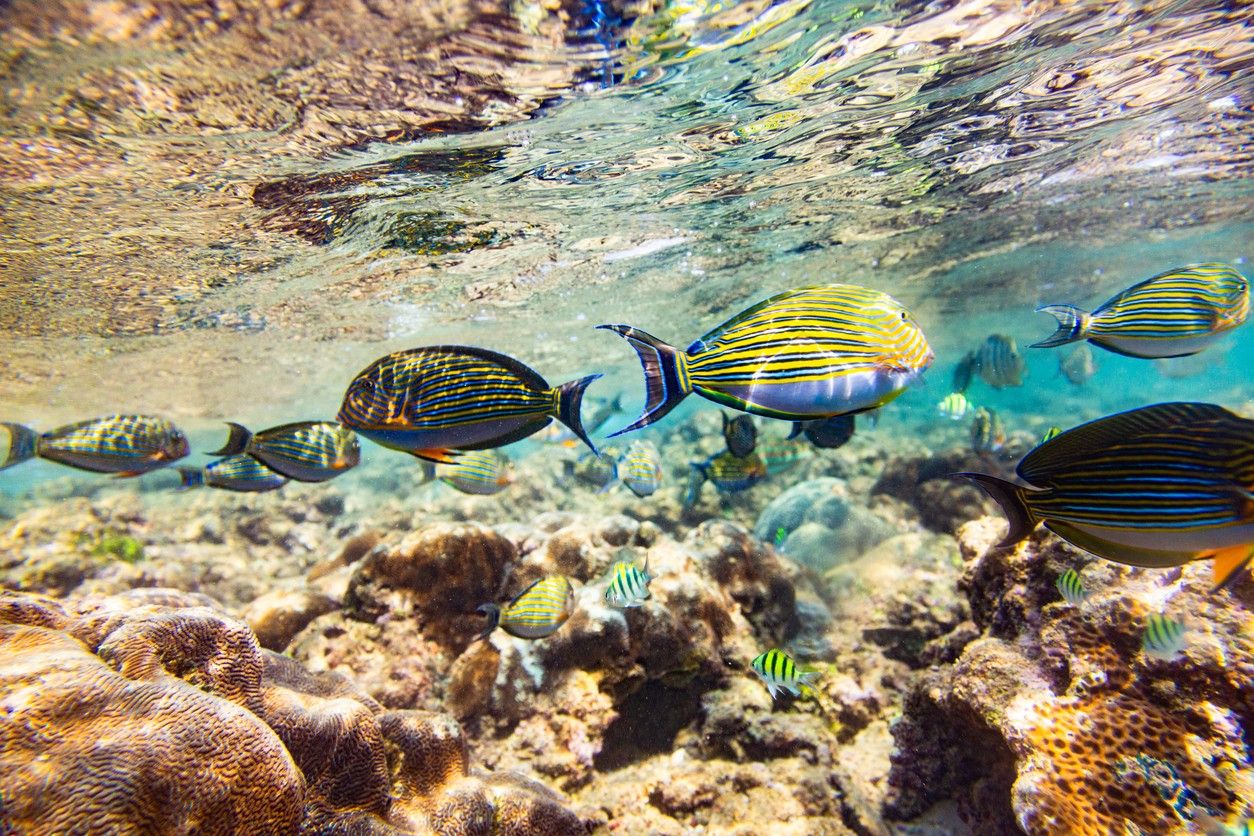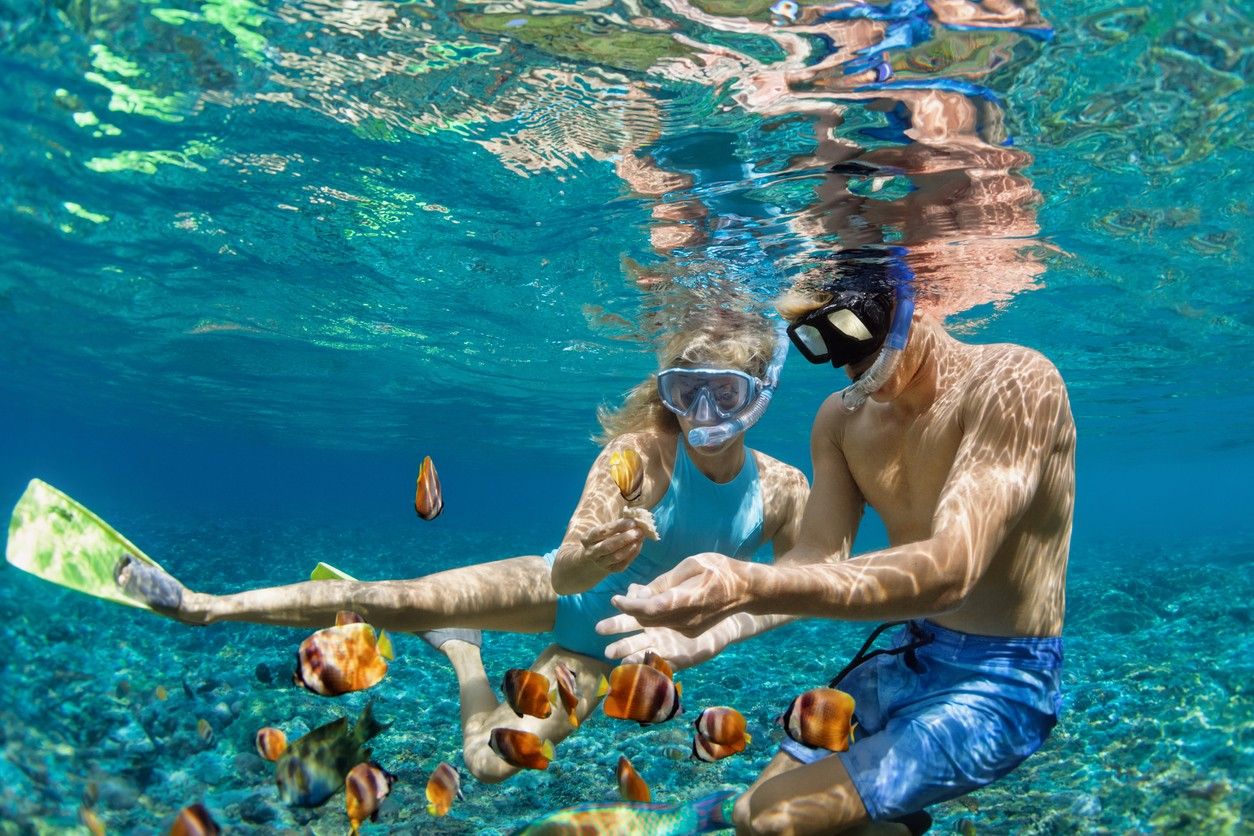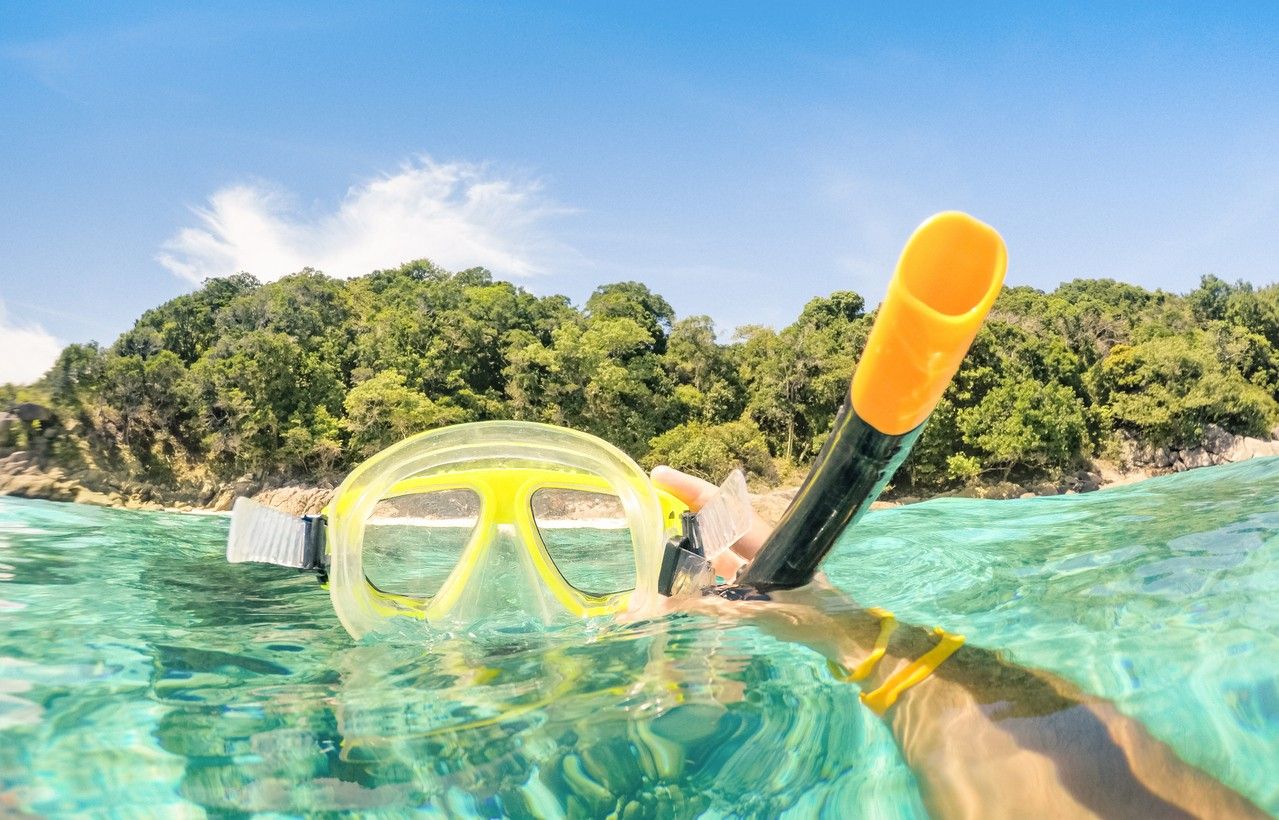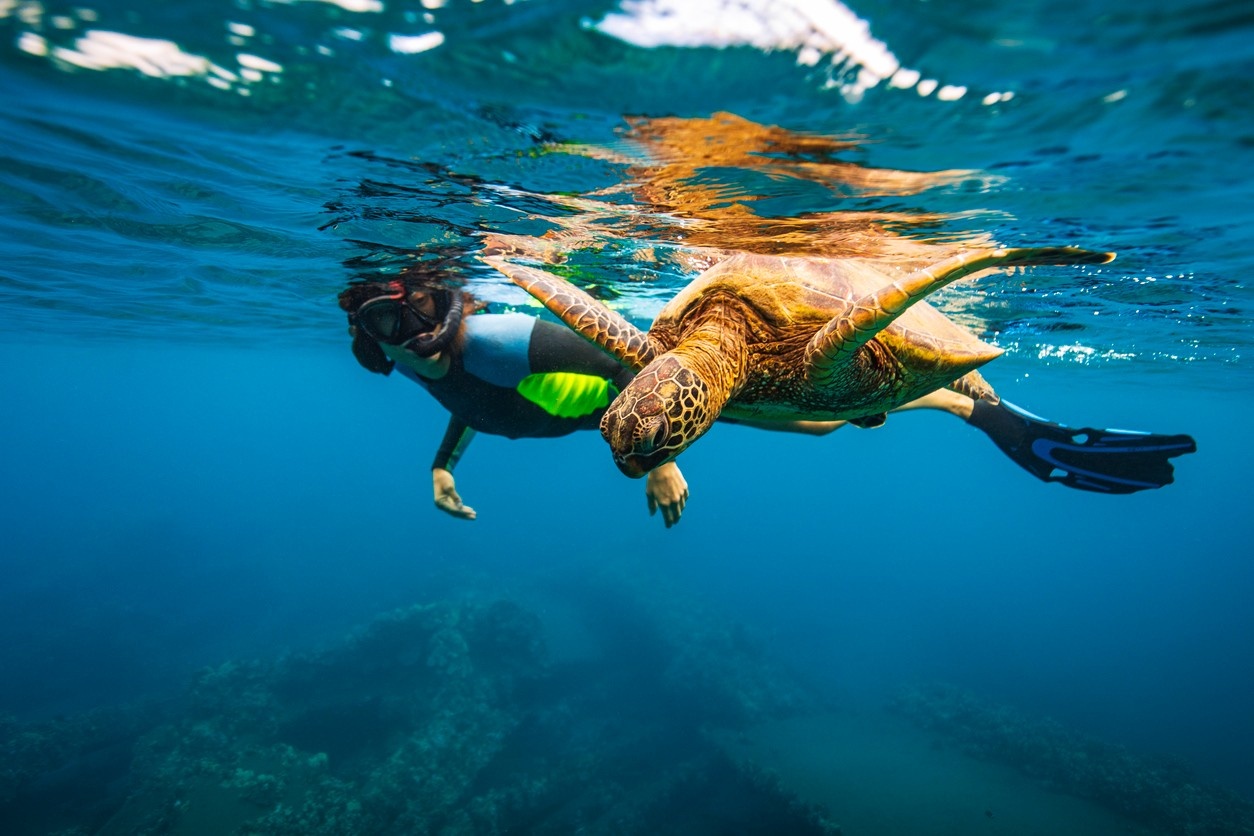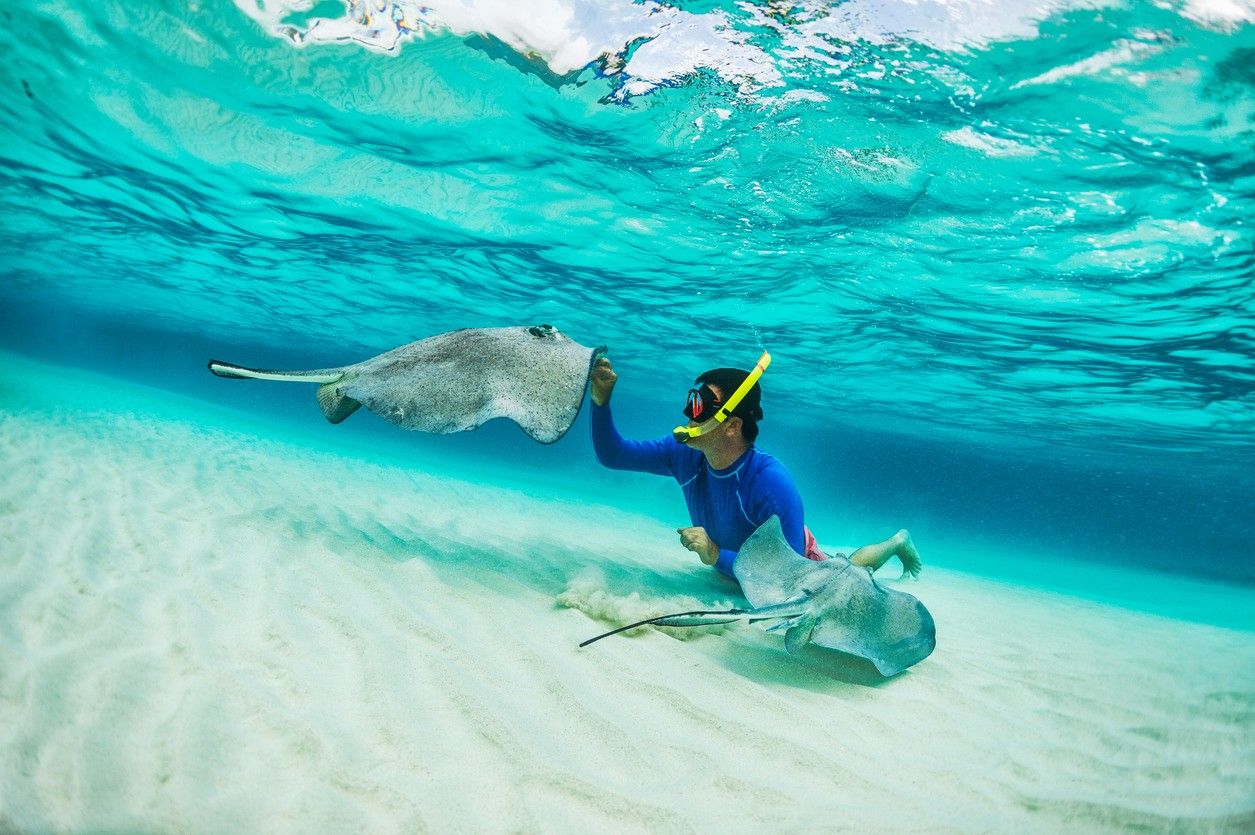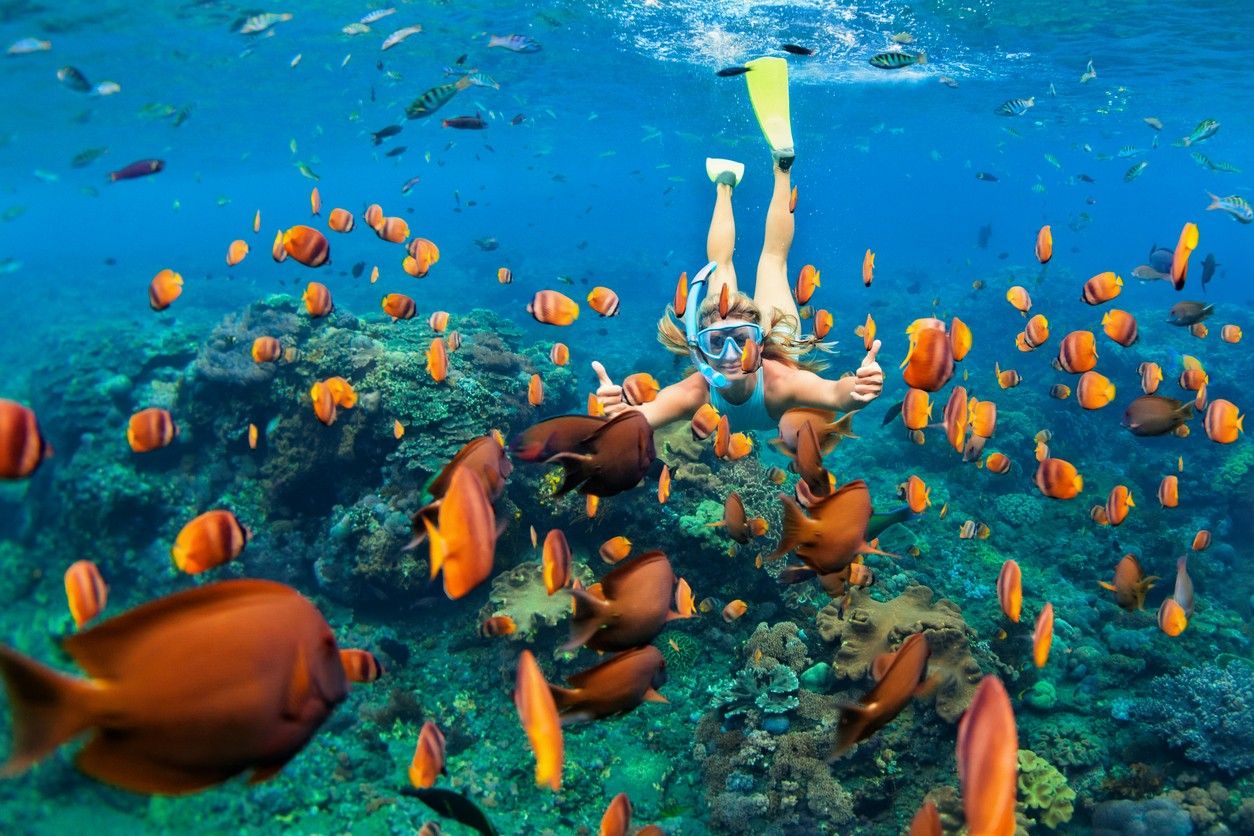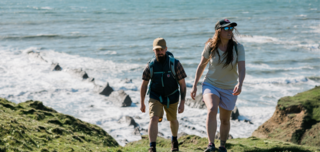Snorkelling is a popular activity that allows people to explore the fascinating underwater world without the need for extensive training or expensive equipment. By using a snorkel mask, snorkel, and fins, snorkelers can observe marine life and coral reefs up close while floating on the surface of the water. Snorkeling is enjoyed by people of all ages and skill levels, from beginners to experienced swimmers The basic snorkelling gear consists of a mask, snorkel, and usually fins. The mask covers the eyes and nose, allowing the snorkeler to see underwater. The snorkel is a curved tube that attaches to the mask and extends above the surface of the water, enabling the snorkeler to breathe while face-down on the surface. Fins worn on the feet enhance propulsion and mobility in the water.
In recent years, full-face snorkel masks have gained popularity as an alternative to traditional mask and snorkel sets. These masks cover the entire face and have a built-in snorkel, offering a wider field of vision and easier breathing for some snorkelers. However, it's important to choose a high-quality, well-designed full-face mask to ensure safety and comfort Snorkelling can be enjoyed in many locations worldwide, from tropical reefs to rocky coastlines. Some of the best places to snorkel include coral reefs with abundant marine life, clear shallow waters with good visibility, and protected bays or lagoons with calm conditions. Popular snorkelling destinations include the Caribbean, Hawaii, the Great Barrier Reef in Australia, and the Red Sea. Whether using a classic snorkel and mask or opting for a modern full-face snorkelling mask, this accessible and rewarding activity opens up a whole new underwater world to explore. With just a few pieces of gear, snorkelers can immerse themselves in the beauty and wonder of the ocean and create unforgettable memories.
Choosing the Right Snorkelling Equipment
Having the right snorkelling equipment is essential for a safe and enjoyable experience. When selecting gear, consider the following items:
Mask — A well-fitting snorkelling mask is crucial for clear underwater vision and comfort, forming a tight seal against the face without gaps or leaks.
Snorkel — A snorkel allows you to breathe while your face is submerged, with various styles available such as classic J-shaped tubes, semi-dry snorkels with splash guards, and dry snorkels with float valves.
Fins — Fins enhance propulsion and reduce fatigue while swimming, with full-foot fins suitable for casual snorkelers and warm water, and open-heel fins offering more power and versatility.
Snorkel vest — A snorkel vest provides added buoyancy and safety, helping snorkelers conserve energy and stay afloat in the water.
Wetsuit or rash guard — Depending on water temperature and personal preference, a wetsuit or rash guard can provide thermal insulation and protection from the sun and marine life.
Defogger — Defogger solution helps prevent mask fogging, ensuring clear visibility throughout your snorkelling session.
Snorkel keeper — A snorkel keeper is a small clip that attaches the snorkel to the mask strap, preventing the snorkel from floating away if accidentally dislodged.
Mesh bag — A mesh bag is useful for carrying and storing your snorkelling gear, allowing water to drain and the equipment to dry quickly.
When assembling your snorkel set, make sure all components are compatible and securely attached. Test your gear in a pool or shallow water before venturing into open water to ensure a proper fit and function. Investing in high-quality, well-fitting snorkelling equipment will greatly enhance your comfort, confidence, and overall experience in the water.
Learning Basic Snorkelling Techniques
Mastering basic snorkelling techniques is essential for a safe and enjoyable experience in the water. Here are the key techniques to practice and refine:
Fitting your gear — Before entering the water, take a few moments to adjust your mask and snorkel, ensuring a snug and comfortable fit. Make sure the mask skirt forms a tight seal against your face without gaps or leaks, and that the snorkel is securely attached to the mask strap.
Breathing through the snorkel — When you're ready to start snorkelling, wade into waist-deep water and put on your mask and snorkel. Lower your face into the water at a 45-degree angle and take a few slow, deep breaths through the snorkel to get used to the sensation of breathing through your mouth while your face is submerged. If water enters the snorkel, simply exhale forcefully to clear the tube.
Kicking and swimming — Once you're comfortable breathing through the snorkel, start swimming by kicking gently with your fins while keeping your arms relaxed at your sides. Use a slow, steady flutter kick to propel yourself forward, keeping your fins just below the surface of the water. Maintain a streamlined body position to conserve energy and reduce drag.
Clearing your mask — If your mask fogs up or water enters, you'll need to clear it to maintain good visibility. To clear a fogged mask, lift your head out of the water and gently press on the top of the mask while exhaling through your nose. To remove water from your mask, tilt your head back slightly, press the top of the mask against your forehead, and exhale through your nose while lifting the bottom of the mask away from your face.
Diving down — When you spot something interesting underwater and want to take a closer look, you can perform a shallow dive. To do this safely, take a deep breath, bend at the waist, and use your arms to guide yourself downward. Equalise the pressure in your ears by pinching your nose and gently blowing out as you descend. Remember to never hold your breath while diving, as this can lead to serious injury.
Surface swimming — If you need to cover a longer distance or take a break from snorkelling, you can switch to surface swimming. Roll onto your back, float horizontally, and use a gentle flutter kick to propel yourself forward. Alternatively, you can swim breaststroke or sidestroke, keeping your head above water and breathing normally.
By practising these basic snorkelling techniques, you'll be able to move through the water with confidence and ease, allowing you to fully immerse yourself in the underwater world. Remember to always snorkel within your skill level, stay aware of your surroundings, and prioritise safety above all else.
Safety Tips for Snorkelling
While snorkelling is generally a safe and accessible activity, it's important to follow certain guidelines to minimise risks and ensure a positive experience:
Check conditions — Before entering the water, assess the currents, waves, and weather to ensure safe snorkelling conditions.
Snorkel with a buddy — Always snorkel with a partner for support and safety, establishing hand signals or other communication methods beforehand.
Choose an appropriate site — Select a snorkelling area that matches your skill level and experience, opting for shallow, calm waters with good visibility and minimal boat traffic.
Protect your skin — Wear a rash guard or wetsuit and apply high-SPF, water-resistant sunscreen to protect your skin from the sun's harmful rays.
Stay hydrated — Drink plenty of water before and after snorkelling, and avoid consuming alcohol or heavy meals before entering the water.
Be mindful of marine life — Respect the marine environment by avoiding touching, stepping on, or disturbing coral reefs and other delicate habitats, and keep a safe distance from marine life.
Know your limits — If you feel fatigued, cold, or uncomfortable at any point during your snorkelling session, exit the water and take a break.
Signal for help — In case of an emergency, remain calm and signal for help from your snorkelling buddy or nearby boats, carrying a whistle or other signalling device to attract attention if needed.
Equalise ear pressure — When diving down, equalise the pressure in your ears by pinching your nose and gently blowing out to prevent discomfort or injury.
Practice good buoyancy — Maintain neutral buoyancy and avoid kicking up sand or sediment, which can damage coral and reduce visibility.
By prioritising safety and following these guidelines, snorkelers can minimise risks and fully enjoy the wonders of the underwater world. Remember to respect the ocean and its inhabitants, and always put your well-being and that of others first.
How Can I Practice Snorkelling in a Pool Before Going in The Ocean?
The key is getting relaxed and confident using your snorkelling equipment in the controlled pool environment before transitioning to the more dynamic conditions in the ocean. Focusing on proper breathing, positioning, finning, and clearing your mask in the pool will make your ocean snorkelling much more enjoyable.
Get comfortable with your gear. Practice putting on your mask, snorkel, and fins and adjusting them for a proper fit. Wear your gear in the pool to get used to how it feels before using it in the ocean.
Practice breathing through the snorkel. Put your face in the water with the snorkel in your mouth and take slow, deep breaths. Get used to the sensation of breathing through your mouth with your face submerged. Practice short exhalations out of the snorkel while swimming around before coming up for air.
Work on your body position. Keep your body horizontal and face down in the water, looking slightly forward. Avoid lifting your head too much, which can strain your neck. Use your legs and fins to kick and propel yourself, rather than your arms.
Practice clearing your mask. Learn how to remove water from your mask by pulling the bottom slightly away from your face and exhaling through your nose. Master clearing your mask underwater so you're prepared if it floods while snorkelling.
Develop your finning technique. Use a smooth, steady flutter kick with your fins to move through the water efficiently. Keep the kicks small and avoid splashing on the surface to conserve energy.
Try diving down. Once comfortable with the basics, practice taking a deep breath, diving below the surface, and swimming down to retrieve objects on the pool floor. This helps prepare you for diving down to get a closer look at marine life in the ocean.
What Are the Best Exercises to Improve My Snorkelling Endurance?
The key is combining cardiovascular exercises like swimming and running to build aerobic capacity, with functional strength training for the legs and core. Exercises that mimic the motions of snorkelling, along with practising with the snorkel itself, will best prepare your body for the endurance demands of the sport
Swimming laps. Focus on building good rhythmic breathing habits and work on distance and endurance rather than speed. Swimming laps help build your cardiovascular fitness and stamina for snorkelling.
Running exercises. Running or jogging improves your aerobic capacity and leg strength which are important for snorkelling. Incorporate both longer, slower runs and shorter, high-intensity intervals.
Squats and lunges. These lower body exercises strengthen your leg muscles which power your kicks and swimming while snorkelling. Squats and lunges help build muscular endurance.
Planks and core work. A strong core is key for maintaining proper body position in the water while snorkelling. Planks, sit-ups, and other ab exercises will improve your core strength and stability.
Yoga and mobility drills. Flexibility is important for efficient swimming and kicking technique. Yoga and stretching routines can improve your range of motion and reduce the risk of cramping while snorkelling.
Practice swimming with a snorkel. Using a snorkel while swimming laps lets you focus on stroke technique and breathing rhythm without interruption. Alternate laps with and without the snorkel to get used to the feeling and build specific snorkelling endurance.
Best Snorkelling Destinations Around the World
One of the greatest joys of snorkelling is the opportunity to explore diverse underwater landscapes and encounter fascinating marine life in destinations around the globe. From vibrant coral reefs to crystal-clear lagoons, the world is full of incredible snorkelling spots that cater to all skill levels and interests.
The Caribbean — A premier snorkelling destination, with countless islands and cays offering warm, turquoise waters and abundant sea life. Some of the best snorkelling in the Caribbean can be found in the Bahamas, where the extensive Andros Barrier Reef and the shallow waters of the Exuma Cays are home to colourful fish, sea turtles, and even friendly nurse sharks.
Mexico's Yucatan Peninsula — Another snorkelling hotspot, with the world's second-largest barrier reef running along its coastline. The island of Cozumel is renowned for its clear waters and diverse marine life, while the nearby Riviera Maya offers snorkelling opportunities in stunning cenotes and protected marine reserves.
Hawaii — The island boasts some of the most iconic snorkelling sites in the world, such as Hanauma Bay on Oahu and the Molokini Crater off the coast of Maui. These volcanic islands are surrounded by fringing reefs that support a wide array of tropical fish, sea turtles, and even the occasional dolphin or whale.
Australia's Great Barrier Reef — A bucket-list destination for snorkelers, with over 2,900 individual reefs and 900 islands stretching for over 2,300 kilometres along the country's northeast coast. The reef is home to an astonishing diversity of marine life, including giant clams, sea turtles, rays, and over 1,500 species of fish.
The Maldives — An archipelago of over 1,000 islands in the Indian Ocean, is a snorkeler's paradise known for its crystal-clear lagoons, vibrant coral gardens, and abundant marine life. Many resorts in the Maldives offer house reefs that can be accessed directly from the shore, making it easy for snorkelers of all skill levels to explore the underwater wonders.
Other notable snorkelling destinations include the Red Sea in Egypt, where the warm, nutrient-rich waters support a wide variety of coral and fish species; the Raja Ampat Islands in Indonesia, known for their incredible biodiversity and pristine reefs; and the Philippines, where snorkelers can explore World War II wrecks and swim with whale sharks in Donsol Bay. No matter where your snorkelling adventures take you, remember to practice responsible tourism and minimise your impact on the delicate marine ecosystems you encounter. By choosing eco-friendly tour operators, using reef-safe sunscreen, and avoiding single-use plastics, snorkelers can help protect these incredible underwater worlds for generations to come.
Related Articles

Let us know you agree to cookies
We use marketing, analytical and functional cookies as well as similar technologies to give you the best experience. Third parties, including social media platforms, often place tracking cookies on our site to show you personalised adverts outside of our website.
We store your cookie preferences for two years and you can edit your preferences via ‘manage cookies’ or through the cookie policy at the bottom of every page. For more information, please see our cookie policy.
